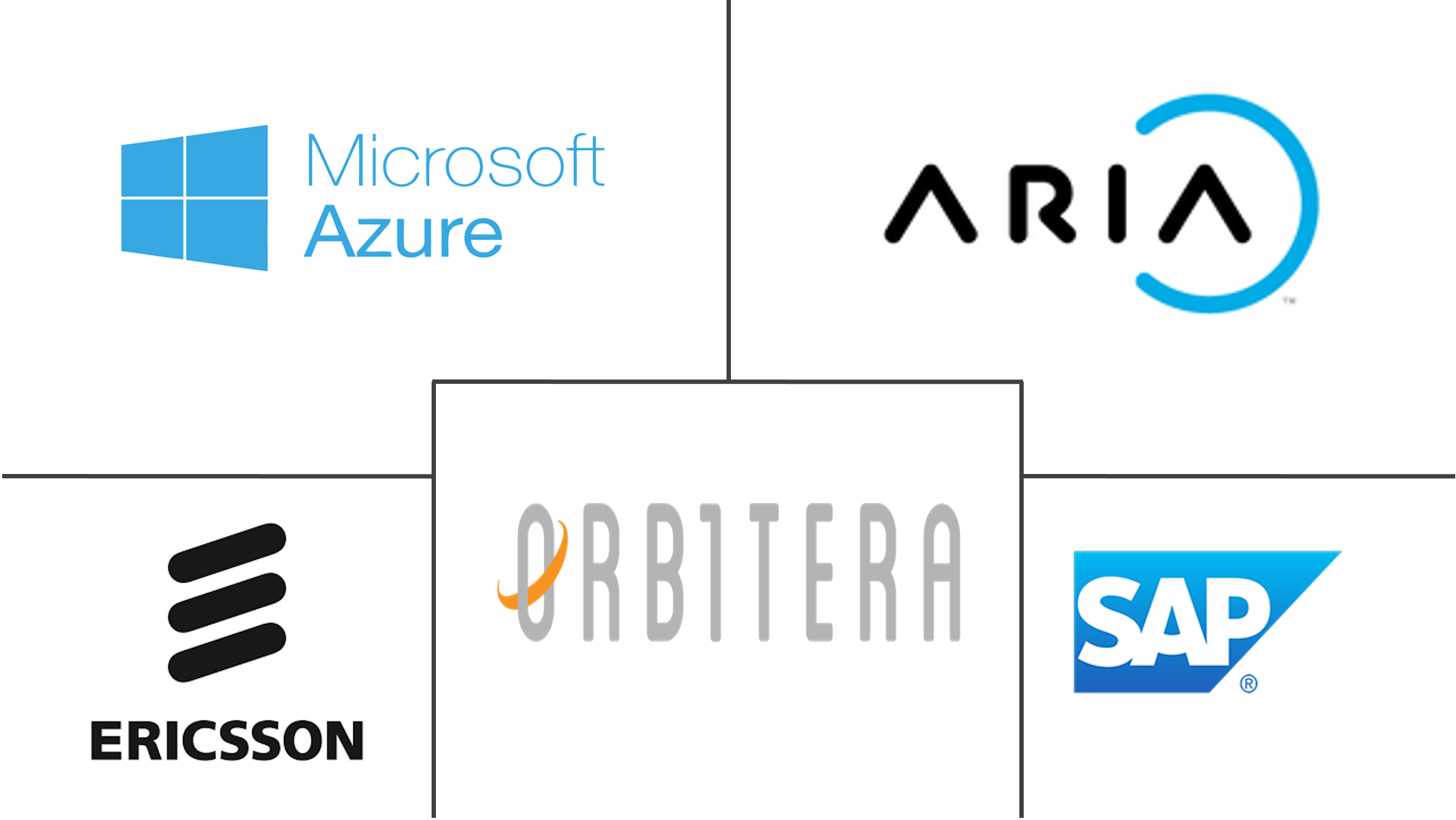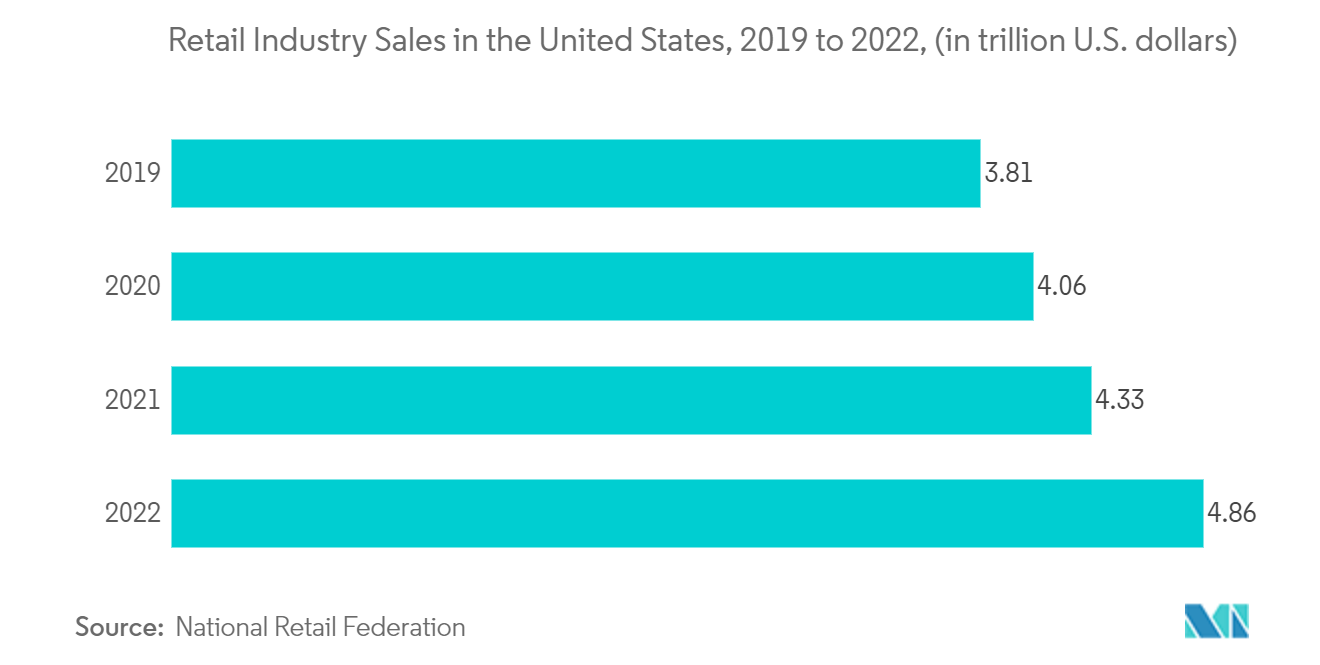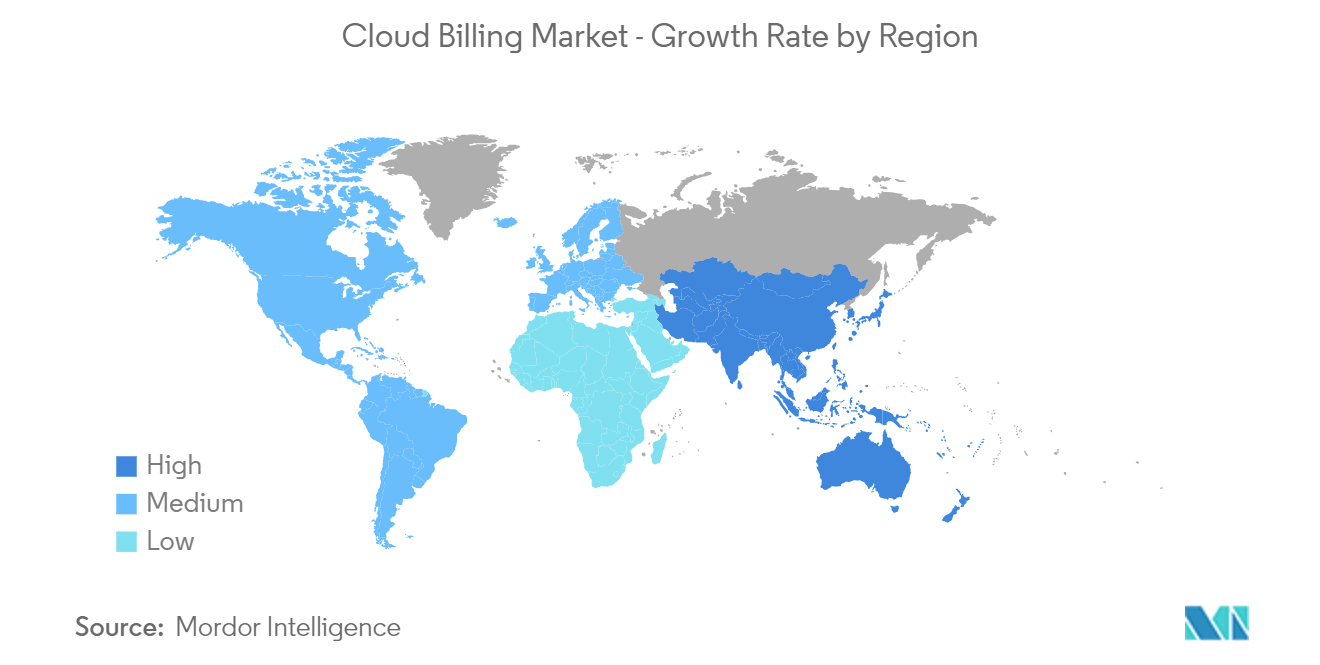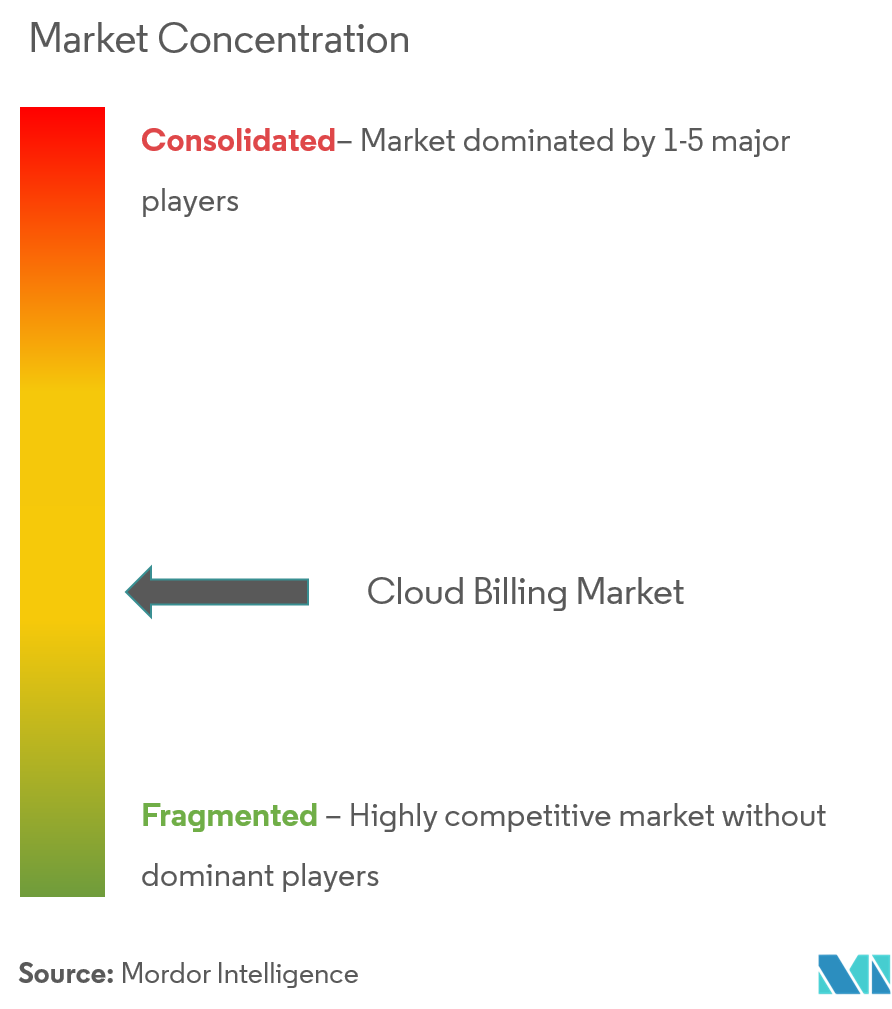Cloud Billing Market Size

| Study Period | 2019 - 2029 |
| Base Year For Estimation | 2023 |
| CAGR | 23.00 % |
| Fastest Growing Market | Asia Pacific |
| Largest Market | North America |
| Market Concentration | Low |
Major Players
*Disclaimer: Major Players sorted in no particular order |
Cloud Billing Market Analysis
Cloud Billing Market is expected to grow at a CAGR of 23% during the forecast period. With the growing instances of adoption of cloud computing, the demand for cloud billing solutions is also increasing. The major benefits provided by cloud billing solutions are cost benefits, higher scalability, secured services, and improved efficiency in operations.
- As the industry's technological landscape changes, businesses are looking for cost-effective ways to increase their competitiveness in the market. Cloud billing solutions are cost-efficient as they help in reducing the cost of resources and the IT infrastructure, thus driving the demand for the cloud billing system.
- Also, the massive growth in e-commerce and virtualized workplaces is increasing the need for simplified operations and billing process transparency, further driving the market growth. Also, the growth of the cloud-based POS system is giving rise to cloud billing in the retail sector.
- The growing requirement for lower capital and operational expenditures is projected to propel the cloud billing industry forward in the future years. Billing developed from a discrete back-office product to an integral component of the complete quote-to-cash process with the arrival of the cloud. Cloud billing enables organizations to save money while providing exceptional customer service. According to Flexera research, in the last year, 89% of firms desire multiple-hybrid cloud. As a result, the growing need for cheaper capital and operational expenses drives the expansion of the cloud billing industry.
- However, the transition from on-premises to cloud-based billing solutions, especially in small and medium firms, is expected to hinder the market growth. This is due to the costs involved with the transformation and privacy and data security issues related to cloud billing solutions.
- The COVID-19 outbreak had a favorable influence on the cloud billing business. Due to the worldwide lockdown, cloud billing systems have become popular as businesses implement new and inventive invoicing ways. The popularity of cloud-based billing systems increased significantly during the COVID-19 pandemic due to their cheap cost and scalability.
Cloud Billing Market Trends
This section covers the major market trends shaping the Cloud Billing Market according to our research experts:
Retail Sector Expected to Show Maximum Application
- The rise of e-commerce giants has resulted in a substantial surge in the sales of products and services over the online platform, increasing the number of digital documents such as invoices and bills. This has made it imperative for the e-commerce players to have solutions like cloud billing that enable them to effectively and efficiently manage resources and operations, thereby enabling them to provide a smooth experience to their consumers.
- Businesses are quickly adopting cloud technology to manage better and analyze data to gain real-time insights. Furthermore, cloud migration allows businesses that rely on retail to explore new business opportunities within their company and provides retailers with a much-needed competitive edge over traditional retail outlets.
- The expanding retail sales industry is likely to fuel the cloud billing market. As per the National Retail Federation, overall retail sales in the U.S. reached nearly 4.86 trillion U.S. dollars last year, up USD 53 billion from the previous year. Grocery shops, restaurants, and booksellers are examples of retail establishments. The U.S. has around four million retail enterprises.
- Technological advancements are shaping the cloud billing industry. Major cloud billing firms are focusing on providing technology solutions for cloud billing to speed up business growth.
- For instance, in January this year, Oracle expanded its full retail cloud infrastructure by adding the Oracle Retail Payments Cloud Service. With the technology, U.S. merchants can take the most up-to-date contactless payment alternatives, such as debit/credit cards and Apple, Samsung Pay, and Google, without the added charges and unpredictability that eat into their profits. This is all done with clear, fixed-fee pricing, with no contract extensions, lock-ins, or monthly minimums.

North America Expected to Dominate the Market
- North America is anticipated to dominate the cloud billing market during the forecast period, owing to the presence of major solution providers in the region. Also, the region has always remained at the forefront of technology adoption.
- The retail market in North America is expanding rapidly, particularly in nations such as Canada and the United States. The retail industry in North America is one of the largest, owing to the existence of businesses such as Costco, Walmart, Home Depot, Kroger, and Target.
- Furthermore, North America is the market leader for retail cloud solutions. Compared to many other regions, the region features one of the more innovative retail environments. In addition, cloud solutions are widely used in specialty retailers in the region.
- Retail sales in the United States are expanding significantly; this rise is likely to generate demand for cloud billing for processing huge volumes of transactions. According to the US Census Bureau, retail sales in the United States in January last year were nearly USD 518.15 billion, and retail sales in October last year were estimated to be around USD 597.83 billion.
- Furthermore, market participants having a presence in the region are creating technologies to acquire a competitive advantage. Oracle, for example, announced new tools in March last year to see and control the cloud subscription and invoicing directly in the Oracle Cloud Interface. These capabilities were developed in close collaboration with a group of Oracle Cloud Infrastructure (OCI) clients and were motivated by their requirements to meet major billing use cases. Consequently, this new feature adds to the company's commitment to providing a superior ownership experience by making cloud paying and usage more straightforward.

Cloud Billing Industry Overview
The cloud billing market's competitive landscape is gradually shifting towards fragmentation, owing to the presence of various solution providers across the globe. However, due to the increased instances of cloud adoption in various regions and end-user industries, the market competitiveness amongst the players is also increasing. Also, new and emerging players are entering the market, hence diluting the market share. Moreover, many existing major players are forming new strategies and partnerships to stay ahead of the competition in the market. In September 2022, Gentrack was chosen by Pulse Energy, a top provider of energy and broadband services, to be their system transition partner. The collaboration will accelerate organizational change and assist Pulse Energy in creating fresh client journeys throughout its enterprise. The Gentrack Cloud Billing and Operations solution will be made available on Amazon Web Services (AWS) as a transition component, with additional cloud services for meter reading data, business analytics and insights, and intelligent integration driven by Snowflake. In March 2022, Aria Systems, the market leader in assisting companies in growing subscription and usage-based income, announced that EXA Infrastructure, the first dedicated digital infrastructure platform linking North America and Europe, has successfully integrated its cloud billing platform and has begun invoicing for current products utilizing Aria. Following the USD 2.15 billion sales from GTT Communication, which had chosen Aria to serve as the new entity's billing provider starting in April 2021, EXA was established.
Cloud Billing Market Leaders
-
Orbitera, Inc.
-
Microsoft Corporation
-
SAP SE
-
ARIA Systems, Inc.
-
Telefonaktiebolaget LM Ericsson
*Disclaimer: Major Players sorted in no particular order

Cloud Billing Market News
- January 2023: Input 1 is a pioneer in payments, digital billing, and premium financing solutions. HawkSoft, a supplier of insurance technologies for agency management systems, announced a strategic agreement to allow premium collecting capability for HawkSoft agencies. For more than 30 years, Input 1 has improved its comprehensive payments and billing platform, which reduces the complexity of the full lifecycle of premium collecting. Input 1 services are used by more than 125 carriers, financial organizations, managing general agents, and thousands of insurance agents to collect and bill premiums from their clients.
- March 2022: The AWS Billing Conductor was introduced by Amazon Web Services, Inc. (AWS). With the assistance of this application, users can efficiently and rapidly provide end users or organizational units with personalized price and cost knowledge. Customers can give personalized pricing and cost insight for their business units or end customers by using AWS Billing Conductor. The connection between clients and AWS in terms of invoicing and billing is unaffected by the AWS Billing Conductor. The purpose of AWS Billing Conductor is to serve clients with certain chargeback requirements.
- March 2022: Rentokil North America, the market leader in controlling pests worldwide, has chosen Aria's cloud-based billing platform to handle billing throughout multiple lines of business, according to an announcement from Aria Systems, the industry leader in assisting businesses to grow subscribers and usage-based revenue. After considering several options, Rentokil decided to use Aria for its billing and monetization system. To support the firm's rapid expansion, Aria will streamline account receivable operations, minimize the number of manual processes, and improve billing efficiency.
Cloud Billing Market Report - Table of Contents
1. INTRODUCTION
- 1.1 Study Deliverables
- 1.2 Study Assumptions
- 1.3 Scope of the Study
2. RESEARCH METHODOLOGY
3. EXECUTIVE SUMMARY
4. MARKET INSIGHT
- 4.1 Market Overview
-
4.2 Industry Attractiveness - Porter Five Forces
- 4.2.1 Bargaining Power of Suppliers
- 4.2.2 Bargaining Power of Buyers/Consumers
- 4.2.3 Threat of New Entrants
- 4.2.4 Threat of Substitute Products
- 4.2.5 Intensity of Competitive Rivalry
- 4.3 Industry Value Chain Analysis
- 4.4 Assessment of CIVID-19 Impact on the Market
5. MARKET DYNAMICS
-
5.1 Market Drivers
- 5.1.1 Increasing Adoption of Cloud Computing
- 5.1.2 Growth in E-commerce Platforms
-
5.2 Market Restraints
- 5.2.1 Transition From On-Premise to Cloud-Based Solutions
- 5.2.2 High Costs Involved and Data Privacy Issues
6. MARKET SEGMENTATION
-
6.1 By Deployment
- 6.1.1 Public Cloud
- 6.1.2 Private Cloud
- 6.1.3 Hybrid Cloud
-
6.2 By Component
- 6.2.1 Platform
- 6.2.2 Services
-
6.3 By End-user Industry
- 6.3.1 Retail
- 6.3.2 Power & Energy
- 6.3.3 Healthcare
- 6.3.4 Telecommunications
- 6.3.5 BFSI
- 6.3.6 Other End-user Industries
-
6.4 Geography
- 6.4.1 North America
- 6.4.1.1 United States
- 6.4.1.2 Canada
- 6.4.2 Europe
- 6.4.2.1 United Kingdom
- 6.4.2.2 Germany
- 6.4.2.3 France
- 6.4.2.4 Rest of Europe
- 6.4.3 Asia-Pacific
- 6.4.3.1 China
- 6.4.3.2 India
- 6.4.3.3 South Korea
- 6.4.3.4 Rest of Asia-Pacific
- 6.4.4 Latin America
- 6.4.4.1 Brazil
- 6.4.4.2 Mexico
- 6.4.4.3 Rest of Latin America
- 6.4.5 Middle East & Africa
- 6.4.5.1 United Arab Emirates
- 6.4.5.2 South Africa
- 6.4.5.3 Saudi Arabia
- 6.4.5.4 Rest of Middle East & Africa
7. COMPETITIVE LANDSCAPE
-
7.1 Company Profiles
- 7.1.1 Orbitera Inc.
- 7.1.2 Microsoft Corporation
- 7.1.3 SAP SE
- 7.1.4 ARIA Systems, INC.
- 7.1.5 Telefonaktiebolaget LM Ericsson
- 7.1.6 Oracle Corporation
- 7.1.7 Amazon Web Services, Inc.
- 7.1.8 BillingPlatform
- 7.1.9 FinancialForce
- 7.1.10 Zuora Inc.
- *List Not Exhaustive
8. INVESTMENT ANALYSIS
9. MARKET OPPORTUNITIES AND FUTURE TRENDS
** Subject To AvailablityCloud Billing Industry Segmentation
Cloud Billing refers to the process of generating bills from resource usage data using a set of predefined billing policies. Cloud-based billing solutions manage the difficulty associated with the delivery of digital and non-digital services and provide robust support for integration. The purpose of a cloud billing solution is to provide an interface for generating usage bills. The Cloud Billing Market is segmented by Deployment (Public Cloud, Private Cloud, Hybrid Cloud), Component (Platform, Services), End-user Industry (Retail, Power & Energy, Healthcare, Telecommunications, BFSI, Other End-user Industry), and Geography (North America, Europe, Asia Pacific, Latin America, and Middle East and Africa). The market sizes and forecasts are provided in terms of value (USD million) for all the above segments.
| By Deployment | Public Cloud | |
| Private Cloud | ||
| Hybrid Cloud | ||
| By Component | Platform | |
| Services | ||
| By End-user Industry | Retail | |
| Power & Energy | ||
| Healthcare | ||
| Telecommunications | ||
| BFSI | ||
| Other End-user Industries | ||
| Geography | North America | United States |
| Canada | ||
| Geography | Europe | United Kingdom |
| Germany | ||
| France | ||
| Rest of Europe | ||
| Geography | Asia-Pacific | China |
| India | ||
| South Korea | ||
| Rest of Asia-Pacific | ||
| Geography | Latin America | Brazil |
| Mexico | ||
| Rest of Latin America | ||
| Geography | Middle East & Africa | United Arab Emirates |
| South Africa | ||
| Saudi Arabia | ||
| Rest of Middle East & Africa |
Cloud Billing Market Research FAQs
What is the current Cloud Billing Market size?
The Cloud Billing Market is projected to register a CAGR of 23% during the forecast period (2024-2029)
Who are the key players in Cloud Billing Market?
Orbitera, Inc., Microsoft Corporation, SAP SE, ARIA Systems, Inc. and Telefonaktiebolaget LM Ericsson are the major companies operating in the Cloud Billing Market.
Which is the fastest growing region in Cloud Billing Market?
Asia Pacific is estimated to grow at the highest CAGR over the forecast period (2024-2029).
Which region has the biggest share in Cloud Billing Market?
In 2024, the North America accounts for the largest market share in Cloud Billing Market.
What years does this Cloud Billing Market cover?
The report covers the Cloud Billing Market historical market size for years: 2019, 2020, 2021, 2022 and 2023. The report also forecasts the Cloud Billing Market size for years: 2024, 2025, 2026, 2027, 2028 and 2029.
Cloud Billing Industry Report
Statistics for the 2024 Cloud Billing market share, size and revenue growth rate, created by Mordor Intelligence™ Industry Reports. Cloud Billing analysis includes a market forecast outlook to 2029 and historical overview. Get a sample of this industry analysis as a free report PDF download.



